The junk and dhow are two ancient ship models that are prominently featured on banknotes in dozens of countries
Images of national pride, of rich history and economic strength, of autonomy and cultural heritage have served to round out and embellish banknotes from all ages and corners of the world. The junk and dhow have remained staples on notes from the East for centuries because they exhibit all of the above qualities, and allow printers to express the full spectrum of characteristics for multiple countries.
The junk and dhow are millennia-old ship models, marvels of engineering, captains of trade, and the vessels that furnished the mingling of cultures. Their hulls hold the values and history of dozens of countries, and between them they dominate note designs across an entire hemisphere.
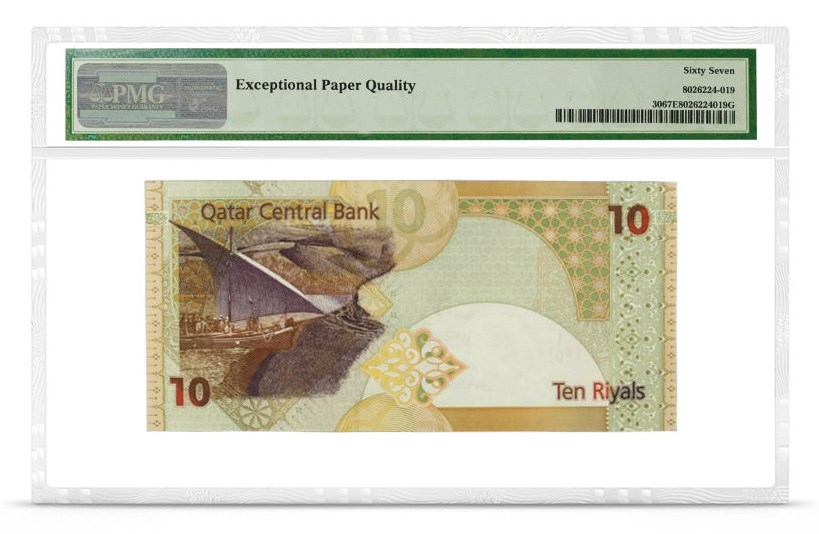
Qatar, Central Bank, Pick# 30, ND (2008), 10 Riyals
PMG Graded 67 Superb Gem Uncirculated EPQ, back. All images courtesy PMG
The Eastern Hemisphere, bustling since the dawn of naval trade by way of the waters of the Indian Ocean, the Persian Gulf and the Red Sea, saw the junk and dhow flourish. Pick 30 from Qatar, a nation bordering the Persian Gulf, twice shows the nation’s emblem on the face: two swords cradling a dhow. The back left exhibits a crewed dhow slicing through a stylized sea.
The dhow played a huge role in Qatar’s dominance in pearl hunting and the dye trade from Greco-Roman times into the Middle Ages. So lucrative was the trade through the Persian Gulf that ship-building was the most important manufacturing industry in the region–a proud, closely guarded profession stretching down the Gulf to what is now the United Arab Emirates. Qatar’s Pick 30 dhow design reflects the nation’s historical economic success in the region. Continued signature renewal for this note series stretching back to 2003 suggests an enduring pride in Qatar’s historical wealth and also in its current status as the country with the world’s highest average income at $132,000 USD per year.
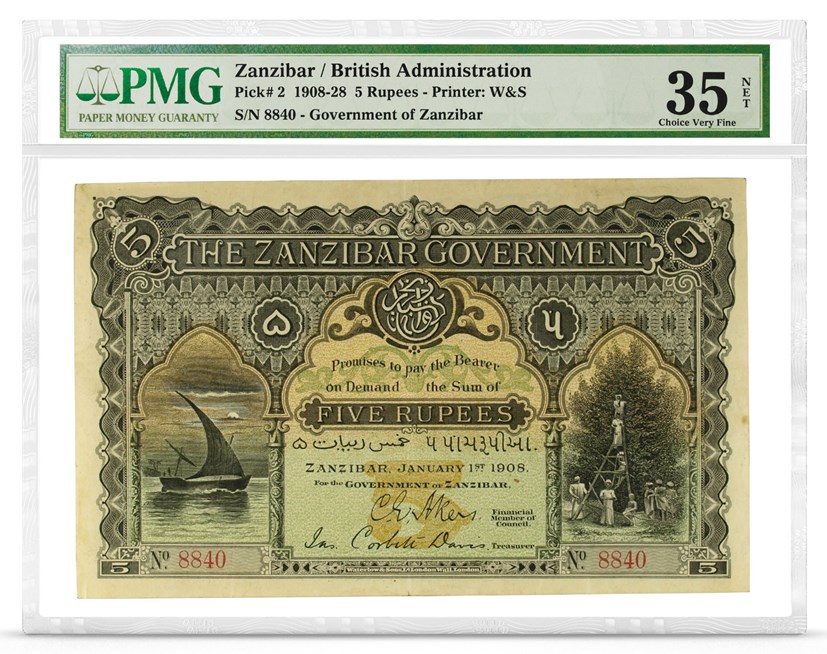
Zanzibar / British Administration, Pick# 2, 1908-28, 5 Rupees. PMG Graded 35 Choice Very Fine NET, front
The dhow’s impact on Eastern trade is not limited to its cargo. Although it shuttled ivory, gold, and timber up the diverse African coastline and fish and dates through the Arabian Peninsula, the dhow itself was crafted from resources imported from the entire Arabian region and was responsible for the spread of ideas and culture as well.
For example, the last port of call for a common sea trade route was through Stone Town in Zanzibar, a trade post off the coast of Eastern Africa. It soon became a hub for sailors from all over the Eastern Hemisphere. In 2000, the United Nations Educational, Scientific and Cultural Organization (UNESCO) named it a World Heritage Site due to its “intense seaborne trading activity” and “outstanding material manifestation of cultural fusion and harmonization.” All of Zanzibar’s listed notes have dhows on the face and, like Pick 2 above, show the boats opposite agricultural activity (spice and fruit made up the island’s primary exports for centuries).
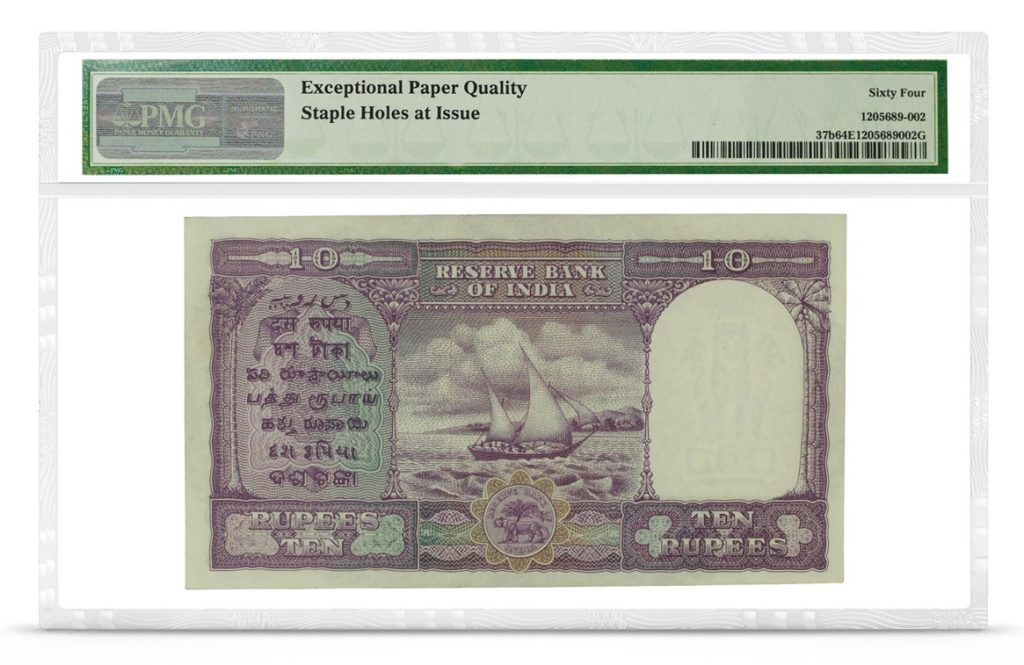
India, Reserve Bank, Pick# 37b, ND (1951), 10 Rupees. PMG Graded 64 Choice Uncirculated EPQ, back
The dhow’s hull lumber was primarily mahogany and ekki from Africa, while teak and coconut wood from India (back of Pick 37b is shown above) made up the masts. The lateen, or almost-triangular type sail rigging for which the dhow is known (a near-triangle rigging allowed for easier hoisting, as opposed to a true one) originated in the Red Sea before reaching Arabia and eventually the Byzantine Empire in Europe. In turn, Portuguese exploration in the sixteenth century influenced an Arabian adoption of a squarer stern for the dhow, which provided more space below deck.
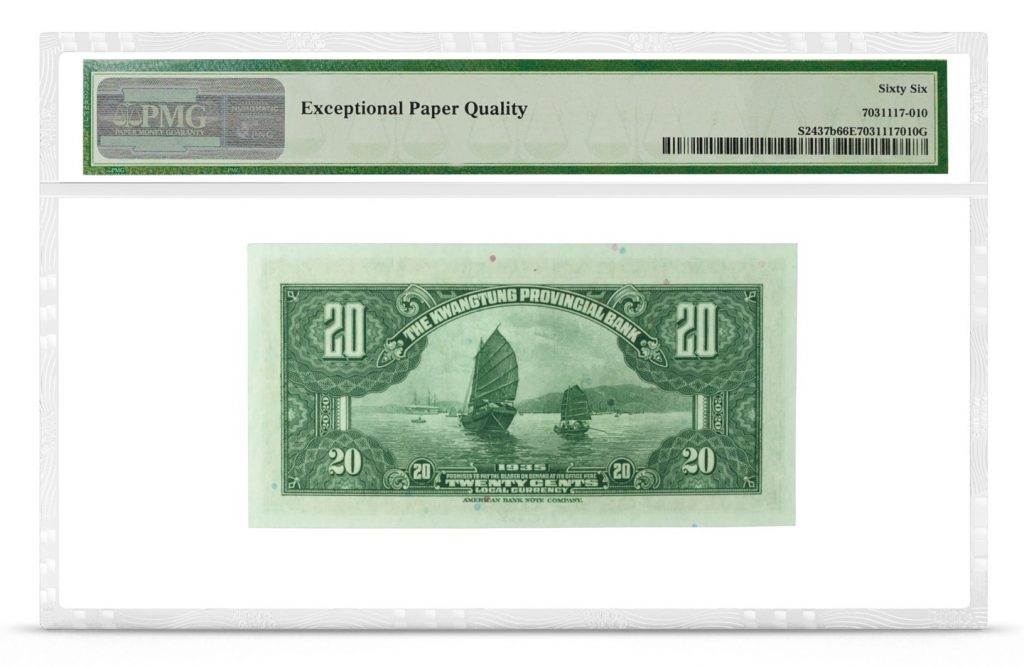
China, Kwangtung Provincial Bank, Pick# S2437b, 1935 20 Cents. PMG Graded 66 Gem Uncirculated EPQ, back
Dating back to the second century BCE, the junk evidences China’s ingenuity in all aspects of shipbuilding. Its eponymous rig, partitioned by wooden battens, made its sails easier to handle and flexible in the face of stronger winds. Historians also attribute the first appearances of flood-preventing bulkheads and a stern-mounted rudder to the junk–both features seen in some cases centuries later in Western vessels. The bulkheads could also double as compartments, creating an organized, sturdy cargo hold. With its adaptability, the junk functioned as small, inland water craft, nine-mast warships, and everything in between.
The reverse of China Pick S2437b showcases two sizes of junks in the same bay–a commonplace for junks all along the southern coast of Asia. As a result, junks can be found on notes from Singapore, Hong Kong, Timor, South Viet Nam, Macau, and other countries from Southeast Asia.
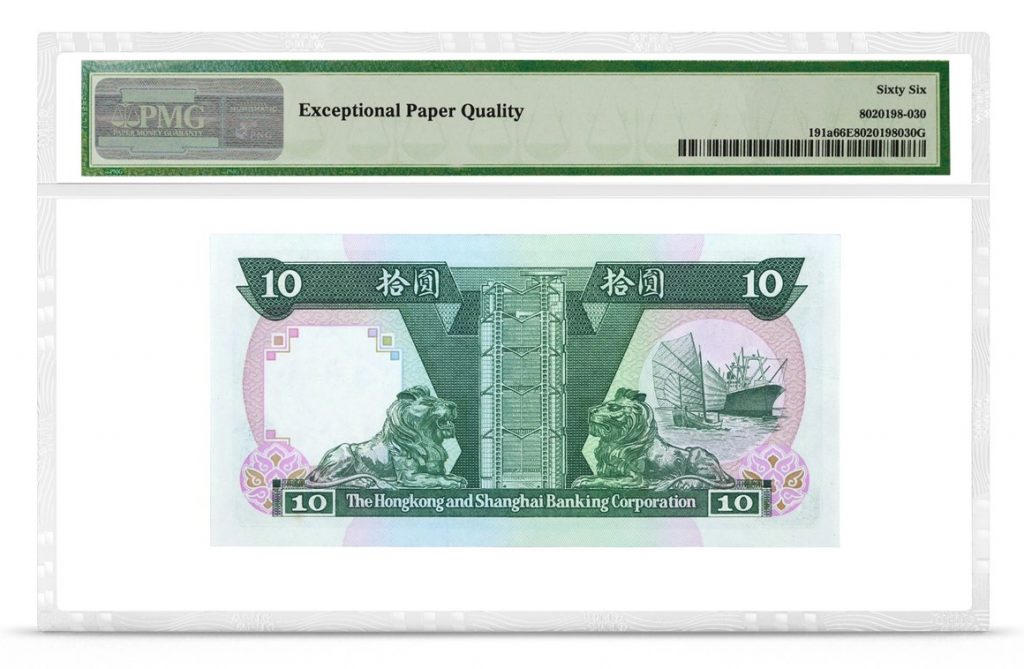
Hong Kong, HK & Shanghai Banking Corp., Pick# 191a, 1985-87, 10 Dollars. PMG Graded 66 Gem Uncirculated EPQ, back
Both the junk and the dhow benefited from European naval terminology and continued to gain fame because of regional differences in ship classification. Traditionally, Western sailors classified ships according to their sail rigging–not the hull, like in the Middle East. So even after design changes in hull, such as the sheer size increases of the junk or more polygonal alterations to the dhow, both ships were always referred to by the same name due to their unmistakable sail setups, which reinforced their revered international status. Today, although the ships have been relegated from major trading due to technological advances in ship power, both continue to serve as hallmarks of many countries on tourist cruises and private sailing ventures. The reverse of Hong Kong Pick 191a portrays the coexistence of a modern trade vessel with the classic junk.
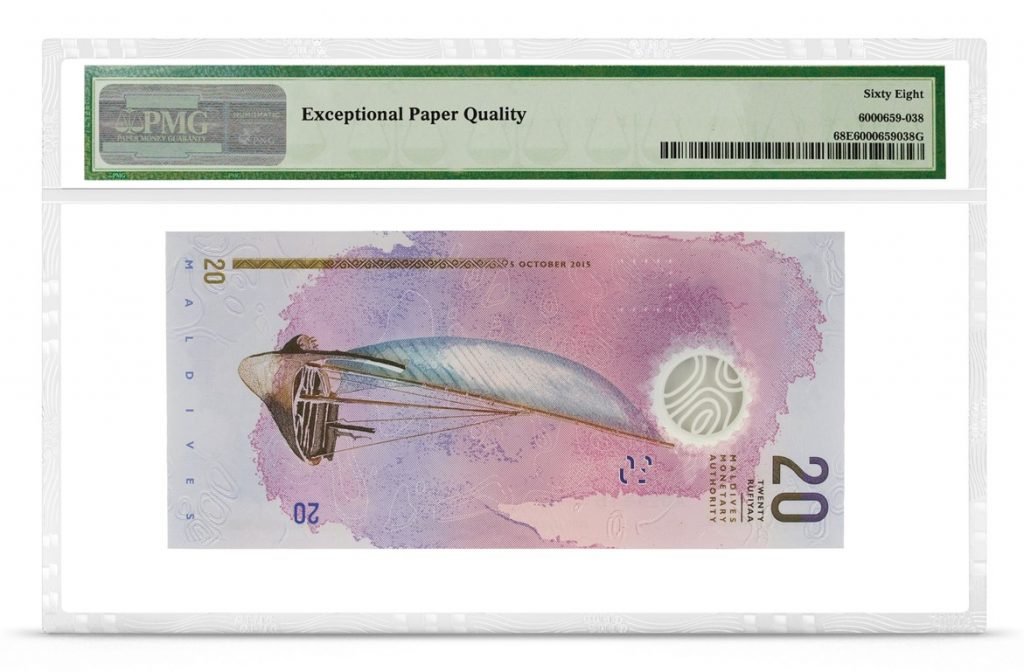
Maldives, Monetary Authority, Pick Unlisted, 2015 / AH1436, 20 Rufiyaa. PMG Graded 68 Superb Gem Uncirculated EPQ, back
Ships as ubiquitous symbols of a nation are not limited to the junk and dhow. The dhoni, native to Maldives and pictured on the reverse of the country’s polymer Pick-unlisted 20 Rufiyaa note, expresses “industrial and economic progress” according to the Maldives Monetary Authority. Many tourist websites describe the ship as “one of the strongest symbols of Maldives,” as they too are traditional craft of their respective region.
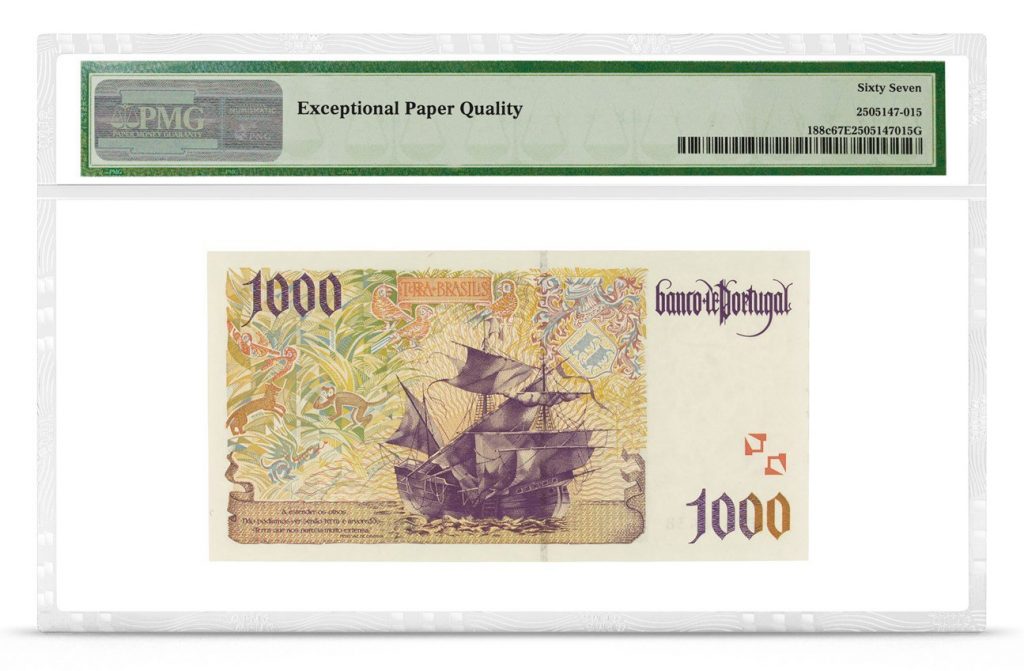
Portugal, Banco de Portugal, Pick# 188c, 1998 1000 Escudos. PMG Graded 67 Superb Gem Uncirculated EPQ, back
The carrack, surrounded by colorful wildlife on the reverse of Portugal Pick 188c, was developed by Portugal and Spain in the late 13th century. It served as a precursor to the ship of line, a model of cannon-burdened warship, but was first used for exploration. Pedro Álvares Cabral discovered Brazil with a fleet of carracks in 1500.
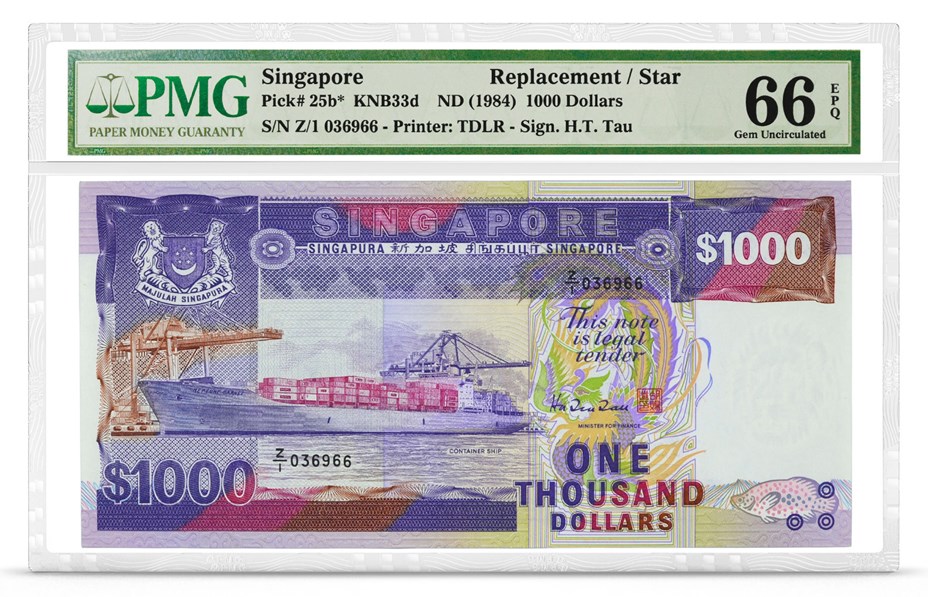
Singapore, Pick# 25b*, ND (1984), 1000 Dollars, Replacement / Star. PMG Graded 66 Gem Uncirculated EPQ, front
Singapore’s entire 1984-1995 series showcases mostly modern cargo ships in and around the sprawling Port of Singapore. The world’s busiest transshipment hub (a stopover destination for cargo) and second busiest port, Singapore will begin using automated yard cranes as soon as 2017—the first location to do so. The port dominates both sides of Pick 25, with the reverse artwork detailing the minutiae of different machinery employed by the dock, including cranes and refueling stations.
* * *
With exploration, trade, and military might as high points of nationalistic, economic, and patriotic pride, it is of little wonder why seafaring craft–especially the dhow and junk–can convey so many different feelings and thematic devices when printed on a banknote. These depictions are a common thread no matter the hemisphere or oceans traveled. And the intercontinental bridging of cultures, goods, and knowledge brought by these influential vessels in no small way mirrors the exchange of a ship-emblazoned banknote between individuals today.




